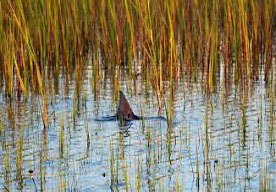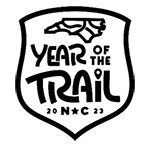2023 is the “Year of the Trail” in North Carolina. North Carolina has partnered with dozens of diverse organizations, agencies, and supporters advocating for increased state investment in all types of trails statewide. Year of the Trail activities can include a walk, hike, paddle, bike or horseback ride in the state forests, national forests, beaches, greenways, estuaries, etc., where the above activities are allowed. You’ll want to check the rules and regulations of each trail before heading out. For example: The Great Smoky Mountain National Park does not allow dogs. Other trails may require your pet to be on a leash at all times. Not all trails allow horses or camping.
So you say, “This is a fishing magazine. What’s this got to do with fishing?” Great question. In my style of fly fishing, I strive for solitude, whether in a tent next to a back country brook trout stream or on a coastal sand flat targeting tailing redfish. I’m always looking for those special places that have little to no human footprints. Typically, the only way to gain access to these hidden places is through hiking, biking, or paddle trails. Today, there are so many tools available to us with technology that finding a trail is not that difficult. Via your smartphone, you can purchase Apps like Gaia, Avenza, All Trails or onX, to name a few, all of which have their own attributes. You can also purchase maps from National Geographic or Gazetteer from outdoor stores for specific regions you wish to visit. The National Forest Service and many states offer free Apps or maps that identify trails. Although they may not be as detailed, they provide a general understanding of the landscape features.
I’m often asked how my obsession with fly fishing began. Most assume a family member or friend must have introduced me to the art. I’ve recently reflected back on this question. As a Baby Boomer kid, I remember the days before the internet, when my brother and I would hike or bike our single speed banana seat bicycles down the railroad tracks to local ponds or several miles to the Oak Orchard Creek to fish. We used rods that were missing guides or the tips were broken off. Every bait or lure imaginable would be carried in one of Dad’s old tin toolboxes–the one missing the carry handle that creaked at the hinges when opening the lid. Although I have those great memories, I don’t think that hooked me to flyfishing. Was I influenced by watching “The Wild World of Sports” and romancing the idea of emulating Flip Pallot and his adventures as he narrated Walker Cay Chronicles? Or could it have been the energizing fast paced action of Jose Wejebe the star of The Spanish Fly and his persistent determination to get the fish to the boat when the fly line was wrapped around a dock pylon? Then it finally came to me; I really didn’t start fishing with a fly rod until my late 30’s when our kids were older and my wife and I started traveling and hiking all over this beautiful country, an appreciation of the tranquility and magic around water emerging inside me. I mentioned to her that I was considering taking up fly fishing. That Christmas, she surprised me with a white Shakespere, two-piece, 7 weight fiberglass fly rod that was recommended by the store clerk at the local sporting goods shop. I’m not sure how many pounds it weighed, with the butt section being the size of a broom handle, but I had fun with it for several months. I didn’t realize then that the weight and the flex of a rod was important–or how the correct accessories made such a difference in the soft presentation of a bug. It wasn’t long before I upgraded to more sophisticated equipment like tapered leaders, Dacron backing, waders and boots.
Since those early years, I fished or hiked portions of 26 states- from the Everglades in Florida to Crater Lake in Oregon, and Acadia National Park in Maine to the gulf coast in Texas. I learned that each state has its own distinct qualities, whether it’s snow covered mountain peaks, sand beaches, or hot deserts that include hiking trails and fishable waters. That’s what got me started in casting a fly rod. It wasn’t specifically about fly fishing in the beginning, but more the incredibly beautiful places we hiked to that guided me to fly fishing opportunities. It also can be argued that flyfishing provided the reason to travel to specific destinations.
Why not add to your hiking adventures, additional memories of catching a 10” wild Brook Trout in each state possible, releasing a 100 pound Tarpon on a Toad fly you tied, or hiking several miles to an Alpine Lake next to a glacier to catch a 20” cutthroat? Some people dream of climbing every high peak east of the Mississippi and some enjoy bird watching or hunting for wild mushrooms. For me, it’s fly fishing into the remotest parts of the country “to boldly go where no man has gone before.” All these activities include using trails.

1. I was researching ncpaws.org to identify wild trout waters in western NC and found Stone Mountain State Park. It’s a beautiful park that includes some great hiking trails. Some of these trails are extremely strenuous and some are easy. A little side note, you can observe people mountain climbing on the face of Stone Mountain, which if you’ve never seen is incredible to watch. Going through the heart of the Park is Stone Mountain Creek, a Delayed Harvest stocked stream that provides the opportunity to catch Rainbow, Brown, or Brook trout just a short walk from the gravel road. Here is the best part: there are many feeder streams that provide opportunities for wild Rainbow and Browns. What do you think follows these streams to where they originate? You guessed it-maintained hiking trails, which in many cases include backcountry campsites. If you’re just exploring and don’t want to carry all your backpacking and fly fishing gear, consider a day trip wet-wading with a 6.5’ or Tenkara rod, a spool of 5X tippet, and a pocket sized fly box with an assortment of size 14-20 dry flies. I think you’ll be surprised at how much fun you’ll have even if you don’t fish.
2. When looking for places to backpack on the eastern portion of the “Mountain to Sea Trail” in NC, I found the Croatan National Forest a few miles west of Beaufort, NC on Route 101. I learned that Beaufort is a quaint little coastal town offering incredible summer saltwater paddling and fly fishing opportunities. The water is easily accessible by canoes or kayaks. There are two state operated boat launches at each end of town, in addition to fishing piers for those that don’t want to get wet. When heading east into Beaufort on Route 70 over the high rise bridge, look down and left or west at the marsh grass. This is a great place to cast a 8 or 9 weight fly rod to tailing Red Fish when the tide is rising or falling. You’ll want a 20 pound leader with a dark colored weighted Clouser Minnow tied with some gold flash. Don’t worry about setting the hook, the Redfish will take care of that. Just hold on and enjoy the workout at this spot, or the many other tidal flats around the Beaufort and Morehead area. You just have to get off the couch and go exploring!
3. Many of our county or local, town Greenways provide access to freshwater fishing opportunities that are often not considered or overlooked. As you paddle or walk along the banks and see mud clouds in the water, it’s likely created by carp that you spooked. If you’ve never fished for carp with a 7 weight fly rod, you don’t know what you’re missing. A successful, stealthy approach and soft presentation of a size 16 Scud or Wooly Bugger, will often provide you the opportunity to see what your backing looks like. You’ll want to inspect all knots in your fly line as they will be tested. During the high heat of summer, when the trout streams are too warm to fish, is the perfect time to pursue carp with a fly.
I challenge you to hit the trails this year and visit these wild places to create your own memories. The complete list of mental and physical benefits is too long to list but it’s proven that anxiety and stress can be reduced with exercise. If you are considering adding fly fishing to your hiking adventures, shorten the learning curve and find a mentor, or hire a guide to learn the fundamentals of casting a fly rod and reading water. Then try going to a local farm pond and catching sunfish or crappie on a 2 or 3 weight before advancing to moving water and bigger fish. Taking a kid fishing adds to the excitement and teaches the fundamentals of “Leave No Trace” while in the wild that should be taught to everyone.

- If you’re the kind of person that rolls the window down in their vehicle to throw bottles, cans or trash out, please stay off our trails.
- If you’re the kind of person that lets their trash blow around when the wind tips over the garbage can and you don’t think it’s your responsibility to clean it up, please stay off our trails.
- If you’re paddling in the water and an item blows off your vessel and you keep going and don’t turn around to pick it up, please stay off our water trails.
- If you don’t think you should dig a hole 8” deep to bury your human waste, then stay off our trails.
Below are a couple reference links for hiking in North Carolina:
www.greattrailsnc.com
www.visitnc.com/story/69Eb/celebrate-year-of-the-trail-in-north-carolina
www.ncdcr.gov/experiences/tripstravel-ideas/north-carolina-trails-guide
Help us keep wild places wild.
Brian Laney is an avid “Blue Line” fly fishing enthusiast. He’s an expert in utilizing canoe and backpack to reach the most remote backcountry in our wildest places. He resides in Raleigh, NC with his wife. He can be reached via email at brian.laney8@gmail.com

